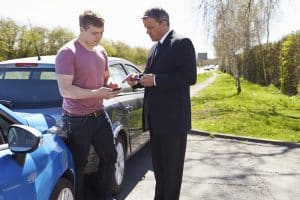
Determining liability in rear-end car accidents isn’t always as clear cut as it seems.
According to the National Highway Traffic Safety Administration, rear-end car accidents are the most common type of road accidents. When a driver is paying more attention to their phone or their passengers, they are more likely to rear-end a vehicle. Usually, the person who rear-ends the other car is going to be held liable for this accident. However, there are some exceptions to this rule. If you are involved in any of the uncommon rear-end car accidents listed below, consult an experienced personal injury lawyer at Simons & Goldner to determine the best legal course of action.
When the Other Driver Is At Fault
All drivers are expected to follow safety rules, which includes leaving a safe distance between you and the driver in front of you. This stopping distance can help prevent rear-end car accidents when someone stops unexpectedly. Often, the car that hits the car in front of it is liable for rear-end accidents. However, there are a few instances in which the driver who is hit in a rear-end collision is at fault. These instances may include:
- When that driver suddenly stops or reverses
- The vehicle’s brake lights are not functioning
- The driver does not pull over or turn on hazard lights after an emergency
Collecting Compensation After a Rear-End Car Accident
In most instances, the process of receiving compensation for property damages from a rear-end car accident is straightforward. However, if there are bodily injuries involved, compensation can become more complicated. This is because the most common injury associated with rear-end collisions is whiplash, which can be challenging to prove and quantify. There have been some cases where drivers exaggerate their symptoms to collect compensation, which makes insurance companies wary of this injury. Take care to obtain medical records of any injuries immediately after the car accident to help your case.
Chain Reaction Car Accidents
A chain reaction accident is a rear-end car accident in which the force of an initial collision causes the car that was hit to crash into the vehicle in front of it. To collect compensation for this kind of rear-end accident, the victim must prove that the driver was negligent. However, more than one driver may be negligent for a chain reaction accident. Collecting the following information can help provide information about the accident and potentially prove who was at fault:
- Eyewitness testimonies
- A police report of the accident
- Vehicle damages
- Pictures of the accident scene, skid marks on the road, vehicle debris
Let Simons & Goldner, P.A. Represent You
Simons & Goldner, P.A., located in Lutherville, MD, consists of two partners, Stevan G. Simons and Richard H. Goldner practicing primarily in personal injury, medical malpractice, Worker’s Compensation, and criminal law. The partners come with decades of experience assisting clients injured by the negligence of others or injured on the job. We serve clients in the Baltimore, Towson, Essex and Dundalk area and work closely with our clients to ensure that your case moves quickly and efficiently and that you get all the benefits to which you are entitled.
Initial consultations are available by phone or in-person and are free of charge. Contact us now to schedule a consultation, or call us today at 410-296-3110. Follow us on Facebook, Twitter, Pinterest, and LinkedIn for advice and updates.
